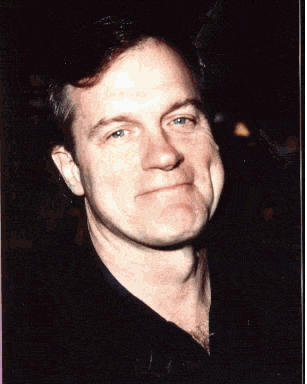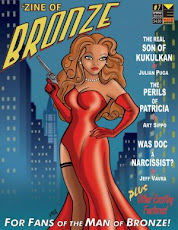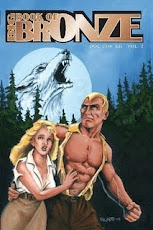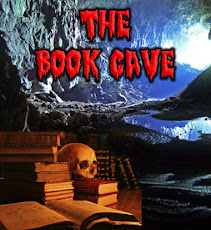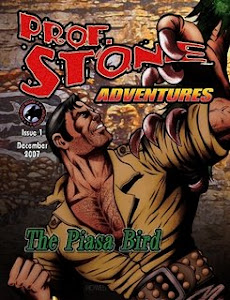
In his pastiche "The Mad Goblin", Philip José Farmer introduced us to the sons of Doc Caliban's aides Jocko and Porky who were his versions of Monk Mayfair and Ham Brooks. These second generation aides were "Pauncho" Van Veelar and Barney Banks. The story was that their mothers had divorced Jocko and Porky and remarried. The boys had been raised by their step-fathers and taken their last names. We were told that they had served together in the Korean War which would have put them in their late teens or early twenties in 1950. They were likely born between 1928 and 1932. We were also told that they had their own "specialties" which were different from those of their fathers, but we were never told what they were.
When I read Phil's book "Tarzan Alive!" in 1972, I assumed that the characters in "The Mad Goblin" were based on actual children of Monk and Ham. In fact, this side story by Farmer made ample sense. It was very unlikely that all of Doc's aides had remained bachelors. So I decided to search for clues to whom the second generation of Doc aides could be.

"Pauncho" Van Veelar was described as tall and heavy set with an abdomen as tight with muscle as the chest of a gorilla. "Pauncho" obviously referred to his girth, but it could have been a play on words. The nickname "Pancho" is used by Mexicans as a nickname for "Francisco" or "Francis". There was one very prominent overweight character named "Frank" who was a good candidate for the real life son of Monk Mayfair and his wife Mabel (about whom we know very little). That was "Frank Cannon" the private detective about whom there was a TV series "
Cannon". Cannon was a retired LAPD Detective (in fact he was once Chief of Detectives) who had a taste for gourmet foods, and luxurious living. He drove a Lincoln Continental Mark IV and fancied himself to be a lady's man. He really sounds like the son of Monk Mayfair.
My sources indicate that Monk had gotten married in the mid 1920s and he and his wife had had two children: Frank (1929) and Angelique (1930). Monk was very active in the late 20s and early 30s in his adventures with Doc and the aides. It was also the case that Monk liked the high life and often stayed out late into the night. His wife felt neglected and suspected that Andrew was cheating on her so she divorced him in 1932. Her father was a very prominent banker on Wall Street and he was able to virtually buy his daughter a divorce. Shortly there after she married a man named George Cannon from her father's firm. George adopted the two children as his own, but they still had visiting rights with Monk which he exercised when he could. George Cannon became involved in his firm's investments in California especially in the movie business and moved his family to to LA in 1937.
My sources indicate that Angelique Cannon followed in her biological father's footsteps and received a doctorate in biochemistry and another in molecular biology. Meanwhile, Frank became a policeman and eventually Chief of Detectives. He retired in 1970.
Porky's son, Barney Banks, was described as tall and thin like his father. My sources have told me that Ham Brooks had been married as a young man and had 4 sons by his first wife, two of whom joined his law firm. But they were far too old to be Barney.
I have discovered that the first Mrs. Brook, Nola, had contracted the dreaded 1918 flu which had killed millions. She did not succumb but remained very ill afterwards and died in 1920 of congestive heart failure and pneumonia. Ham Brooks was distraught. In 1925, he suffered a heart attack. During his recovery, he was assisted by a young law clerk, Dori Kravitz. The two became very close and in 1926, they were married. She became pregnant in 1929. While in labor, Dori Brooks ruptured a cerebral aneurysm and died almost instantly. Her son Bernard Anthony Brooks was delivered by emergency C-Section.
Ham was beside himself with grief. He did not think he could raise a baby by himself. His eldest Son, Barry, and his wife Ginny had been infertile up to that time. They took in little Berney and raised him as their own. As often happens in such cases, once their was a child in the house, the infertility problem vanished and Barry and Ginny Brooks had children of their own.
Berney was different from his siblings, most of whom went into law. He was always a trickster and enjoyed doing stage magic at an early age. Academically, he excelled and sought a degree in psychology. He became an expert in sensory perception and in ways of fooling the senses. His doctoral dissertation was on the perceptual and cognitive illusions used by stage magicians. He had become an amateur magician and studied with some of the great illusionists of the day. Finally, he decided to become a professional magician himself using the stage name Anthony Dorian. (There was another magician by that name and so Berney later had to change it.) His family was not immediately supportive of his choice, but Ham could see the spark of mischief in Berney's eyes and it reminded him of Dori. Ham became his strongest supporter. Eventually, under the pseudonym of Anthony Blake, he became a world renown prestidigitator and made himself a fortune.

His exploits were retold in the
TV Series "The Magician".
"The Mad Goblin" does not mention any other descendants for the aides, but we know about them from other sources.
In a previous
blog, I identified Long Tom Roberts with the character known as Tom Swift. In 1929, Tom Swift married his long time sweetheart Mary Nestor. We know that they had a son, Tom Swift Jr. , born in 1936 who was 18 years old in 1954 when his adventures were first published. Like his father, Tom Jr. was a brilliant inventor and adventurer. He engaged in early spaceflight experiments in the 1950s.
Tom Jr. had a sister, Sandra, who was one year younger than he. Tom and Sandy shared their father's blond hair and blue eyes. Sandy was a gifted scientist and business woman but less interested in adventure than her brother. She eventually took over the management of Swift Enterprises and turned it into a multinational conglomerate.
Renny Renwick did not have any romantic attachments in the Super Sagas. But in the Super Saga "The Ten Ton Snakes" in 1945 we were introduced to Mrs. Carter, his middle aged secretary. She was not described as a raving beauty, but she was a handsome woman who was very efficient at her job. My sources tell me that Elena Carter was the widow of Stan Carter, a construction supervisor who worked with Renny on several projects in the 1930s. Stan Carter's real name was Stavros Karras. He went by an Americanized alias because he thought his name sounded too foreign and he was afraid that it might prevent him from getting good work. He died in late 1937 in an accident during a building project that he was supervising for Renny. He was survived by his wife, Elena, and 2 small children. Renny felt responsible for his death, and tried to help Elena. She did not want to accept charity so he gave a job as his secretary. They had a brief affair in 1938 during which Elena became pregnant. Renny offered to do the right thing and marry her, but Elena was a proud woman and while she loved Renny, she was not in love with him. She declined Renny's proposal. She had their son, Damien, in 1939. Mrs. Carter continued for Renny during the 1940s and 1950s after which she retired.
Damien Carter was a bright but moody child. He was husky and had long arms and large hands from his father. Damien started boxing in Grade School and continued to box throughout the rest of his life. He preferred the nick name Danny to his real name which sounded to exotic to him. He was a Golden Gloves Champion in the New York CYO as a High School Senior. Damien attended Regis High School which was a tuition-free institution run by the Jesuits. "Danny the Hammer" excelled in science but also got a reputation as someone you did not mess with.
He went to Georgetown University and entered the Jesuit order. When he did so, he discovered that his legal name was Karras and so he adopted it. He was technically illegitimate and so he needed a dispensation to enter the order. His biological father, Renny, paid for his education through a trust fund. Damien obtained his medical training at the Georgetown Medical School while simultaneously completing the requirements for a PhD in Clinical Psychology. This was followed with a residency in psychiatry at Johns Hopkins. Fr. Damien Karras became the official psychiatrist of the Jesuit Maryland Province.

One of his most notorious cases was an exorcism in Washington, DC which was documented in the novel"The Exorcist" by William Peter Blatty. Contrary to the ending of the novel, he did not die from the fall out the window, but he was badly injured and recuperated over several months.

There is evidence that Renny married a woman of mixed Chinese and Hawaiian extraction in the 1960s. He apparently was using the assumed name of Randall Fox at that time. This could have been a new identity that he was cultivating because his treatments with Doc Savage's Immortality Formula had made him appear to man in his late 20s.

In any case he and his wife had a daughter named Sydney who was born in Honolulu in 1965 and grew up there. Sydney's mother died in 1976 and the young girl concentrated heavily on her studies. She eventually became a renowned archaeologist and anthropologist who specialized in finding lost artifacts. She was also an expert martial artist. Her adventures were chronicled in the TV series "
Relic Hunter".
Johnny Littlejohn was a consummate academic and continued doing intelligence work for the US Government well into the 1950s. He was the least like of the five to actually get married. But in 1939, he met a feisty lady reporter named Theresa 'Torchy' Blaine who was trying to do an expose on Doc Savage. She and Johnny became involved in a mystery which has not yet been chronicled. Torchy Blaine was a pretty strawberry blond who had a police detective boyfriend Steve McBride who wanted her to settle down and be a conventional house wife. There was quite a lot of pressure on women in those days to do so and to fore go a career outside the home. Torchy loved McBride, but she was not the 'settling down' type.
Johnny found Torchy to be an interesting and intelligent woman who was making her own way in a man's world. It was her unconventional approach to life that attracted him. She was very knowledgeable in politics and had done some overseas correspondent work. He found that there were depths to this woman that no one else had appreciated. Doc and the boys thought she was a little flashy for Johnny and they thought it would be just a brief infatuation.
Torchy was flattered that such an erudite man would take an interest in her. He treated her like a colleague and an intellectual equal. She also found that he needed to loosen up a bit and she introduced him to the Coney Island Cyclone, the Cotton Club, Jitterbug, and Nathan's Famous.
They were a very unlikely couple, but somehow they worked. The two were married in 1940 in a private ceremony attended only by their closest friends. Doc, Pat, and the Boys were there. Steve McBride even attended.
Their early married years found them both pursuing their separate careers but linking up periodically for brief trysts. They wrote and phoned each other as often as they could. Even so in that first year, Torchy became pregnant and had a son they named Laurence. In 1941, she became pregnant again and this time had a pair of twin sons. The boys in those first few years were raised primarily by a governess.
Just before Pearl Harbor, Torchy was promoted to city editor and she had a more regular schedule. She and Johnny had a girl in 1942 they named Mathilda. Torchy identified much more with her daughter than with her sons and spent much more time with her. Mathilda became feisty and unconventional very much like her mother. Meanwhile her brothers were very stuffy and highbrow. All three of them became rather conventional Harvard trained lawyers.

Mathilda Littlejohn was an exceptional child. She was tall - over six feet - lanky, and muscular with green eyes, fire-red hair and a strong independent personality. She was considered a Tom Boy as a child but was actually very athletic and excelled at various sports as well as track and field. Because of her height, and long reach she took up fencing and was rated nationally in all three of the major sport weapons: the Épée, the Foil, and the Sabre. She also took up archery and was one of the few women of her time to master the English longbow.


Academically, Mathilda showed a penchant for literature and history. She entered undergraduate training at age 14 and started graduate studies at 17. She earned a PhD in English literature and eventually completed another PhD in European History. Linguistics was also one of her hobbies and she has earned a Masters in that field. Like father like daughter.
Mathilda became an instructor in the English Department at Columbia University in New York. Eventually, she was awarded a full professorship. She has been very active in women's causes.
She was one of the first women to shatter the 'glass ceiling' in the tenured world of the American University. She also has been an amateur sleuth involved in solving mysteries mostly in an academic setting.
Some of her cases have been chronicled by a fellow feminist academic, Carolyn Gold Heilbrun writing under the pseudonym Amanda Cross. Because of the controversial nature of these cases, Prof. Heilbrun changed the names of the participants to avoid legal problems. She also used the alias of "Kate Fansler" for Mathilda Littlejohn. The first "Kate Fansler" story (In the Last Analysis) was chronicled in 1964 depicting a story about Mathilda when she was a 22 year-old graduate student.
It should be noted that Mathilda eventually married a district attorney who figured prominently in her adventures. His name in Prof. Heilbrun's narratives was given as Reed Amhearst. My sources indicate that he is in reality Arthur Branch, the conservative Republican DA depicted on the Law and Order TV Series.
Branch was originally from Georgia and graduated from Yale University Law School. His first job was as a public defender in New York City and then he later became an assistant DA. He and Mathilda had met while he was a PD when she had been arrested during a college demonstration. They were lovers for a brief time, but eventually this evolved into a friendship. Arthur was always interested in academic law and published several articles during his tenure as an ADA. He also took additional graduate courses at NYU and was awarded an academic doctorate in Law.
In 1970, he was offered a position at Yale Law School. Within 10 years he was an associate Professor. When he was not offered a full professorship, he returned to New York and was hired as a special prosecutor in the early 1980s.
During his time at Yale, Arthur maintained his contacts in the New York DA's office and was often hired as a consultant by them. He maintained a platonic friendship with Mathilda and she often called him for help in some of her adventures.
In 1973, Arthur married a childhood friend, Lillian Matlock, whose brother was a famous criminal lawyer in Atlanta. They had one son, Robert, and two grandchildren, a boy and a girl. Lillian died in a tragic car accident just one year after their coming to New York.
Arthur Branch married Mathilda Littlejohn after a brief courtship. She did not take his name nor does she wear a wedding ring. Arthur does wear his wedding ring proudly.


































